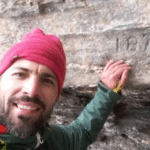Connecting personally in Argentina
- Case studies from IPCC authors
- Conversation shops in Senegal
- Talking your audience’s language in Indonesia
- Energising analogies in Ukraine
- Flooding conversations in Colombia
- The bigger picture in Japan
- Local stories in Mozambique
- Informing policy in the Caribbean
- Stitching in detail in India
- Connecting personally in Argentina
- Neighbourhood interest in the USA
- Unpacking the science in France
This case study is part of a set of case studies commissioned by the IPCC WGI TSU (Intergovernmental Panel on Climate Change, Working Group I Technical Support Unit) and collected by Climate Outreach.
Dr Lucas Ruiz shares how he works to rebalance others’ perceptions of him to help people connect more easily with his work – engaging first and foremost as another fellow person.
 Dr Lucas Ruiz, Instituto Argentino de Nivología, Glaciología y Ciencias Ambientales – Author for Sixth Assessment Report, Climate Change 2021: The Physical Science Basis
Dr Lucas Ruiz, Instituto Argentino de Nivología, Glaciología y Ciencias Ambientales – Author for Sixth Assessment Report, Climate Change 2021: The Physical Science Basis
“I always try to introduce myself as a regular person. Of course, the audience is there to listen to you because you are an expert in climate, but that can create a distance with the audience. It’s better to introduce yourself, what your motivations are for doing your science, and why you care about it. And if you have the time (and the skill!) in being a bit more humorous, this can have a real change on how the audience interacts with you.
I’ve found that it’s important to be clear what your main message is – but in order for this to be clear for different audiences, you have to know who they are and tweak how you communicate it. They need to know why you’re communicating, what you want to communicate, and why it is important for them. For example, in one newspaper article that has an audience from an agriculture-based economy area, I explained how glacier shrinkage is affecting water resources, which is crucial for their livelihoods.
It’s also important to avoid scientific jargon. I like to say that glaciers are like bank accounts, but for water. When plenty of snow (cash) precipitates in the mountains, glaciers ‘save’ some of the snow in the form of ice for the future. In drought years, when there is little snow in the mountains (you have run out of cash), glaciers melt more ice (you use your savings). Unfortunately, glaciers are shrinking, so to top up our savings and replenish our cash account, we need to mitigate the effects of climate change. If not, there will come a time when our savings account will be empty which will have an effect on the amount of melted water going into rivers.
Having said that, audiences do also enjoy being taught the key concepts and given some scientific terminology that has been explained in a way that they can understand. For this reason, the use of good pictures, clear plots, or – even better – short videos, always help to catch the audience’s attention. Even though it can be a challenge to talk in front of an audience, the questions at the end always make it worthwhile and encourages me to do more.”
This case study is a great example of putting the following principles for effective public engagement into practice.
- Principle 2: Talk about the real world, not abstract ideas (see Handbook page 8)
- Principle 3: Connect with what matters to your audience (see Handbook page 11)
- Principle 4: Tell a human story (see Handbook page 14)
- Principle 6: Use the most effective visual communication (see Handbook page 20)
Find out more about the six principles in our Communications Handbook for IPCC scientists and accompanying webinar.

If you would like to contribute a case study of your public engagement experiences as an IPCC author, we would love to hear from you. Please share your stories with the WGI Technical Support Unit directly.
Reports & guides
Sign up to our newsletter
Thank you for signing up to our newsletter
You should receive a welcome email shortly.
If you do not receive it, please check your spam folder, and mark as 'Not Spam' so our future newsletters go straight to your inbox.
